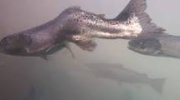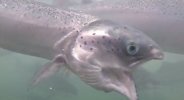There has never been a clearer opportunity for Canada to secure our blue future. As a nation of three oceans and nearly 250,000 kilometres of coastline and existing strengths in innovation, we have a unique competitive edge.

www.canada.ca
Canada’s aquaculture sector sustains the growing of finfish, shellfish, and aquatic plants in ocean spaces, inland waterways, and on land, including in hatcheries. Canadians have differing views about net pen finfish farming and this was made clear by the range of input put forward during various roundtables, in written submissions, and in responses to our online survey. For example, we heard from some that this form of fish farming serves a critical role in the domestic and global food supply chain, while others believe it is inconsistent with the sustainable use of the ocean. We received conflicting recommendations, as well, from making efforts to correct public misperceptions of the industry to transitioning some industry activities out of Canadians waters.
We heard more consistent support from participants in our engagement activities for other forms of aquaculture; especially, the growing of various shellfish species and kelp/seaweed farming. We also heard about the efforts of the sector to develop and adapt to new technologies and innovation, such as new feed stock, to increase sustainability. In addition, we learned about the success of aquaculture in attracting youth, Indigenous peoples and other diverse and under-representative groups to its workforce. Moreover, we heard that ‘done right’ through partnerships, aquaculture can play a significant role in reconciliation. To that end, we heard from a number of Indigenous groups across Canada that they are interested in pursuing aquaculture economic development opportunities aligned to their values.
During our roundtables with sector participants and representative organizations, and in written submissions, we heard about the sustainable growth opportunities in new species, such as sea urchin, sea cucumber, Pacific sablefish and kelp/seaweed. Aquaculture has also been part of the seafood success story during COVID-19 and was recognized as an essential service by federal and provincial governments in terms of food security and economic stability and recovery. It was thus recommended that we should support the economic development of new aquaculture species and promote the essential role of aquaculture in sustainable domestic and global food production—and the future economic prosperity of coastal communities.
We also heard that aquaculture has sustainability advantages, such as:
- access to internationally recognized sustainability and best practices certification programs
- active participation of industry leaders at international sustainability tables
- strict operational regulations regarding animal health and water quality monitoring and the use of pesticides and antibiotics
- advanced technology adoption, including automation, digitalization and traceability
- together with commercial fisheries, contributing the least carbon compared to other food system sectors
To increase its sustainability, we heard that ‘green licences’ to allow industry to test new technology without using existing production for trials, would be beneficial.
To position aquaculture for sustainable growth and prosperity, it was also recommended that we:
- agree on and take action to further develop Canada’s seafood strengths
- develop a 5-year sustainable seafood development plan with measurable objectives
- recognize the diversity of aquaculture across Canada
- foster sector certainty and predictability through government recognition
- collaborate with other departments and agencies (and levels of government) to ensure consistent decision making and streamlined regulations
- expedite development of an aquaculture act
- appoint a federal industry champion for economic seafood sector growth
- recognize aquaculture as a valid user of small craft harbours
- proactively support financing and capacity building for Indigenous-led operations
- accelerate actions to conserve, protect, restore and rebuild marine ecosystems, including to protect aquaculture operations and species from the impacts of climate change
- fill knowledge gaps regarding sustainable use of ocean spaces and new opportunities
- fill policy and regulatory gaps for aquatic plant farming (e.g., seaweed, kelp, etc.)
- quicker and more supportive policy development
- continue to help industry adopt new technologies, including through research and development funding programs
 www.surreynowleader.com
www.surreynowleader.com
 www.surreynowleader.com
www.surreynowleader.com
 www.cedarcoastfieldstation.org
www.cedarcoastfieldstation.org



www.theglobeandmail.com

